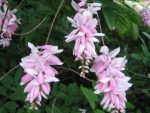 Rosary pea is an evergreen woody vine native to warm temperate to tropical regions of India and Asia but has been introduced in Florida as an ornamental where it has become invasive especially in undisturbed pinelands and hammocks in the central and southern parts of the state. It is a member of the legume family, Fabaceae, that also includes peas, lupines, and mimosa. In various parts of the world the plant has been used medicinally and the seeds have been used for jewelry as well as units of weight because they are so uniform in weight. Photo Credit Shu Suehiro Wikimedia
Rosary pea is an evergreen woody vine native to warm temperate to tropical regions of India and Asia but has been introduced in Florida as an ornamental where it has become invasive especially in undisturbed pinelands and hammocks in the central and southern parts of the state. It is a member of the legume family, Fabaceae, that also includes peas, lupines, and mimosa. In various parts of the world the plant has been used medicinally and the seeds have been used for jewelry as well as units of weight because they are so uniform in weight. Photo Credit Shu Suehiro Wikimedia
Description: This twining vine grows ten to twenty feet long and often climbs over small trees and shrubs. It has a deep root system, slender branches, and two to five inch long leaves that are pinnately compound with five to fifteen pairs of leaflets, each less than one inch long. The flowers are white to pale pink or violet and carried in leaf axils in dense racemes one to three inches long. They give way to flat oblong seed pods that are 1 ½ to 2 inches long and contain three to eight bright red seeds one inch long and with a black spot that has led to another common name, crab’s eye.
Poisonous Properties: Rosary pea contains the deadly toxin abrin that inhibits protein synthesis in growing cells of the intestinal wall and agglutinates red blood cells. It can causes nausea, vomiting, severe diarrhea, weakness, cold perspiration, colic, convulsions, liver failure, accelerated pulse, severe abdominal pain, dilation of the pupils, trembling hands and death after several days. It is most concentrated in the seeds and a single seed contains enough of the toxin to be fatal in humans if well chewed. Abrin does not easily diffuse through the seed coat so an unchewed seed can pass through the human digestive tract without causing harm. Photo Credit Yercaud-elango Wikipedia